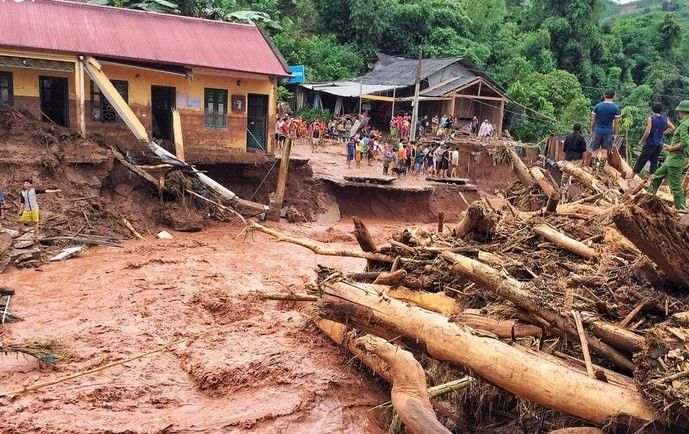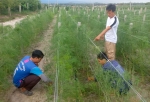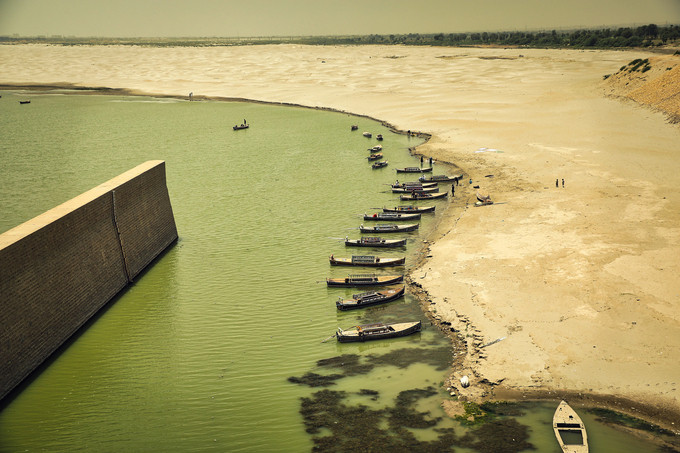Heavy rain is just a triggering factor for landslides
In recent days, landslides and rock slides have continuously occurred in mountainous provinces of the Central Highlands and Northwest, such as Dak Nong, Lam Dong, Coc Pai town, Xin Man district, Ha Giang province, etc. These accidents caused great damage to property, traffic works, and human damage.

Deputy Prime Minister Tran Luu Quang inspects the work of responding and overcoming consequences caused by rain, floods, and landslides at Bao Loc Pass, Lam Dong
Specialized agencies such as the Vietnam Geological Department, the Vietnam Institute of Geosciences and Mineral Resources (VIGMR), the Vietnam Academy for Water Resources (VAWR), etc. have independently reported on the current status, developments, and causes of landslides in provinces of the Central Highlands and Northwest in recent days.
Mr. Pham Van Son, Deputy Director of the VIGMR’s Center for Remote Sensing and Geohazards, said that one of the main causes triggering landslides and rock slides that occurred in mountainous areas of Vietnam is heavy rain.
However, rain is only the triggering factor; the occurrence of landslides also depends on characteristics of topography, slope, and geology. Each place has a different triggering rainfall threshold, so it is necessary to research specifically the rainfall threshold triggering landslides for each area, each type of soil, and each type of rock, depending on water permeability, saturation, and covering.
According to Mr. Pham Van Son, when arranging residential planning and construction work, it is necessary to consider slope locations with a high risk of landslides and rock slides, have plans to drain surface water and groundwater, and warn people in dangerous areas.

The scene of a landslide on Bao Loc Pass (Bao Loc City, Lam Dong) on July 30, killing 3 traffic policemen and 1 citizen
As for traffic roads, it is necessary to consider the roadbed’s stability related to the influence of surface water, groundwater during heavy rain, prolonged rain, and the impact of participating means of transportation.
The General Director of the Viet Nam Meteorological and Hydrological Administration (VNMHA), Mr. Tran Hong Thai, assessed that one of the causes of landslides in some provinces in the Central Highlands and Northern Mountainous Region is prolonged heavy rain that has saturated rocks and soil. In addition, the Central Highlands provinces have the distribution of many basalt volcanic rocks, which have weathered into red soil with characteristics of great thickness, being porous, easily washed away and eroded, and easily destroying structures when saturated with water, so these areas are prone to landslides.
According to General Director Tran Hong Thai, the hydro-meteorological sector is currently localizing the warning zones when there is heavy rain and, at the same time, improving the forecasting and warning capacity in detail for the spots with a risk of landslides for people to prevent.
Two new causes of landslides
According to the General Director of VNMHA, through recent landslides in the Northern Mountainous Region and the Central Highlands, two new causes have been discovered.
First, in Lam Dong province, enterprises have been identified to build embankments and pour outside land into them. This shows loopholes in the work of managing urban order in the locality, so it is necessary to strengthen inspection to prevent this from happening again.
Second, in the Central Highlands and in Xin Man (Ha Giang province), there have been systematic cracks hundreds of meters long. In particular, scientists said that although the Central Highlands have a thick climate layer, the crack extends to 547m with a width of only 20cm.

Heavy rain caused serious landslides in many mountainous provinces
"At this rate, the crack will last longer and deeper, affecting local socio-economic activities, so it is necessary to soon assess the specific causes to give warnings and solutions in the coming time," said Mr. Tran Hong Thai.
According to General Director Tran Hong Thai, in the long term, it is necessary to conduct research and investigations on landslides, rock slides, floods, and flash floods on a large scale. In addition, zoning risk warnings will help the Government and localities grasp the current status and risks of landslides, rock slides, floods, and flash floods and have orientations for socio-economic development planning. At the same time, take measures to prevent and minimize damage to people's lives and properties.
"It is necessary to organize a survey delegation to evaluate scientifically and fully the factors. Especially, survey activities must be coordinated with experts from the Vietnam Geological Department, VIGMR, and experts inside and outside the Ministry of Natural Resources and Environment (MONRE) to make specific and accurate assessments, determine the causes, and forecast the risk and development level of landslide blocks, thereby proposing solutions and contributing to ensuring a peaceful life. This urgently needs to be done soon.
VNMHA will coordinate with relevant units to arrange all resources and soon plan to inspect and survey a number of landslide areas and areas with a risk of geohazards in the Central Highlands in August," said Mr. Tran Hong Thai.
The representative of the Vietnam Union of Geological Sciences proposed to MONRE to continue implementing the project "Investigation, assessment, and warning zonation for landslides in mountainous regions of Vietnam ", and at the same time provide local authorities with specific tasks during the implementation of this project.
Translated by Huyen Vu Thu


















